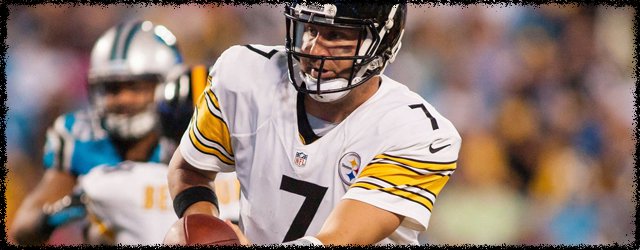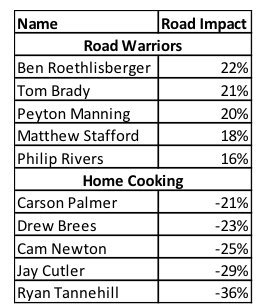There’s No Place Like Home

Looking around the league, the depth of the quarterback position may be at an all-time high. For instance, eighteen quarterbacks in 2013 averaged 15 fantasy points per game, which is more than double the 2001 season where only seven quarterbacks managed the feat. This has further enforced the idea in redraft leagues of the “late round quarterback” and has influenced dynasty leagues to view top wide receivers and tight ends more favorably than top quarterbacks.
This is not an attempt to counter that strategy, but instead to provide a means to help those owners when setting their quarterback roster spot. In this case, the focus is on the idea of home field advantage and if it is applicable to your quarterback matchups. Further, it is a view into which factors play into the home and away games when looking at quarterback performance.
Background
When researching this topic, my mind raced to a few commonly held beliefs when evaluating a quarterback and their upcoming venue:
- Quarterbacks are better at home than on the road.
- Quarterbacks play in a dome and not as well in outside games
- Quarterbacks are no good when it gets colder
These are the questions I have decided to focus on for this article. To be clear, I have no opinion on whether these beliefs are true or not, but it is important to understand if they are factual. Further, I think they lay a good foundation to the broader discussion of quarterback streaming and its effectiveness.
Methodology
This is where things become a little tricky and very complicated. With the focus on the influence of home and road environments, it is important to isolate this and remove other variables from the equation. I am even going to go as far as to bold this next sentence to make this point very clear: Defense is not a factor in this study; it has been accounted for and its influence removed.
With that addressed, let’s talk a little more about how this was done. Game data was extracted for over 2,000 games between 2007 and 2013 for quarterbacks who had avoided major injuries. The idea there is to remove games (and seasons) where a player may have been hampered by injury or had games cut short. We want as clean a sample as possible to avoid distorting the information. So any game that saw a low number of starting quarterback plays and a certain level of backup quarterback plays was discounted from the analysis to again avoid data integrity issues.
Next, I decided to focus solely on a quarterback’s passing statistics and disregard the rushing numbers. By doing this, it made the model easier to control for defensive influences. Additionally, it was more difficult to control other variables around quarterback rushing numbers (e.g. age is a larger variable here compared to passing) so it was decided that its inclusion would compromise the study.
[am4show have=’g1;’ guest_error=’sub_message’ user_error=’sub_message’ ]
Last, specific weights were assigned to games with a higher emphasis on divisional games because these require the least amount of modeling. Since a quarterback plays a home and road game against these teams each season, their comparison is much simpler than non-divisional opponents they only play once in a given year.
This is the abbreviated version of the methodology and setup, but believe me when I say, it took a lot of time to clean the data and set up the analysis. I’ll be happy to discuss this further in the comments section for you fellow nerds interested in finding out more.
Data Analysis
Starting with the most basic question: Is there an influence on playing at home compared to playing on the road? The short answer is no. The longer answer is the overall fantasy impact is neutral, but there are some fluctuations in how a quarterback gets to those totals. Let’s take a look below and see how the numbers compare.

 Overall completion percentages remain unchanged with completions and attempts are roughly equal. However, yardage is a little higher on the road, but it is offset by an increase in interceptions. Touchdowns do remain constant, however, so the influence there is non-existent. As expected, there is a slight increase in sacks and drops, so a quarterback does face some additional challenges from the players around him. All of this can be summed up in the 0.2% difference in fantasy performance by quarterbacks on the road versus at home.
Overall completion percentages remain unchanged with completions and attempts are roughly equal. However, yardage is a little higher on the road, but it is offset by an increase in interceptions. Touchdowns do remain constant, however, so the influence there is non-existent. As expected, there is a slight increase in sacks and drops, so a quarterback does face some additional challenges from the players around him. All of this can be summed up in the 0.2% difference in fantasy performance by quarterbacks on the road versus at home.
What this tells us is that, on the surface, we don’t see a statistically significant difference in performance due to game location. However, looking at this a level deeper, we do notice a trend related to quarterback experience. Looking at the chart to the right, there is a clear home field advantage when a quarterback begins his career, but there is no difference as he enters his prime years. Interestingly, in the later years, a quarterback is actually better on the road. Given the high numbers both on the road and at home during this time, we are dealing with elite quarterbacks who thrive regardless of environment.
Another interesting note regarding quarterback tenure is the gradual performance increases both on the road and at home. They progress and perform better throughout their careers in both scenarios, even if the progression isn’t equal.
Digging into our second question now: Does a dome quarterback struggle more on the road than non-dome quarterbacks? It is an interesting question that I feel like in recent years has been brought up because of Matt Ryan, who does have drastically different numbers at home and on the road. But when you look at the overall impact below, dome quarterbacks, like Ryan, only see about a 4% change in fantasy output due to playing outdoors. By comparison, outdoor quarterbacks see a larger bump (14%) when playing inside.

A few more interesting takes from the chart above include an increase in completion percentage when playing indoors for both quarterback groups. There is also an increase in touchdown output in a dome, but that comes with increases in sacks as it appears the defense sees some benefit as well. Dome quarterbacks are much more susceptible to interceptions on the road (a 50% increase) and their receivers drop 25% more passes than when they play at home. Outdoor quarterbacks see their yardage increase with only a marginal change in drops, likely a result of wide receivers being acclimated to a variety of weather conditions.
Just for fun, let’s see how Matt Ryan’s numbers compare when we control for other factors. Looking below, there is a pretty strong difference in fantasy point impact (15%) when comparing to other dome quarterbacks (4%). Ryan is much more accurate at home and sees over a 3:1 ratio on touchdowns to interceptions. Compare that to the road where his accuracy plummets below 60% and he has as many touchdowns as interceptions, all worse than the average dome quarterback. Ryan also gets sacked more, which is worse than the average dome quarterback and experiences more drops on the road (which aligns to other dome quarterbacks).

Overall, Ryan is just an average play on the road and is a star at home, justifying the critics who cite this as a reason why he is perceived to be below the truly elite.
Moving on to the last question: Do quarterbacks perform worse in cold weather? This is the most difficult question to answer as controlling for weather conditions can be difficult. Changes in temperature, wind speed, humidity, and other forces of nature prove challenging to account for. However, even looking at the most basic levels, we see some variation in performance. As shown below, in outdoor games occurring after Thanksgiving, we do see a slight decline in overall performance compared to earlier in the season (-6%).

Dissecting it a little further, we see that the attempts go down slightly along with the completion percentage. Overall yardage and touchdowns go down in late season games, showing a more conservative nature to the passing game. Interestingly, interceptions decrease in these games, which I also believe is due to the more conservative play quarterbacks adopt when it gets cold. Sacks and drops remain the same however, which shows that the quarterback is impacted more by the weather change than his surrounding players.
Conclusion
After reviewing all of the various questions related to the home field advantage, what have we learned?
- We don’t see a home field advantage at the highest level
- Experience plays a factor in how a quarterback performs at home and on the road. The overall progression is positive as experience increases but there are road struggles early in their career.
- A quarterback whose home field is outdoors sees a greater lift from playing in a dome than a dome-based quarterback sees when they play at home versus the road.
- Colder weather games have a mild impact on a quarterback’s fantasy performance as they become more conservative
Since not all quarterbacks are created equal, here are the quarterbacks that see large differences in their home and road performances:

Thanks for reading and feel free to leave comments about the article or ideas for future pieces.
Also, don’t forget to follow me on Twitter @Rotohack
[/am4show]
- Bowl Game Previews: CFB Playoff Semifinals - December 28, 2018
- The Narrative Fallacy and How it Compels Us - May 13, 2017
- 2017 NFL Draft – College Wide Receiver AIR - April 27, 2017

































































